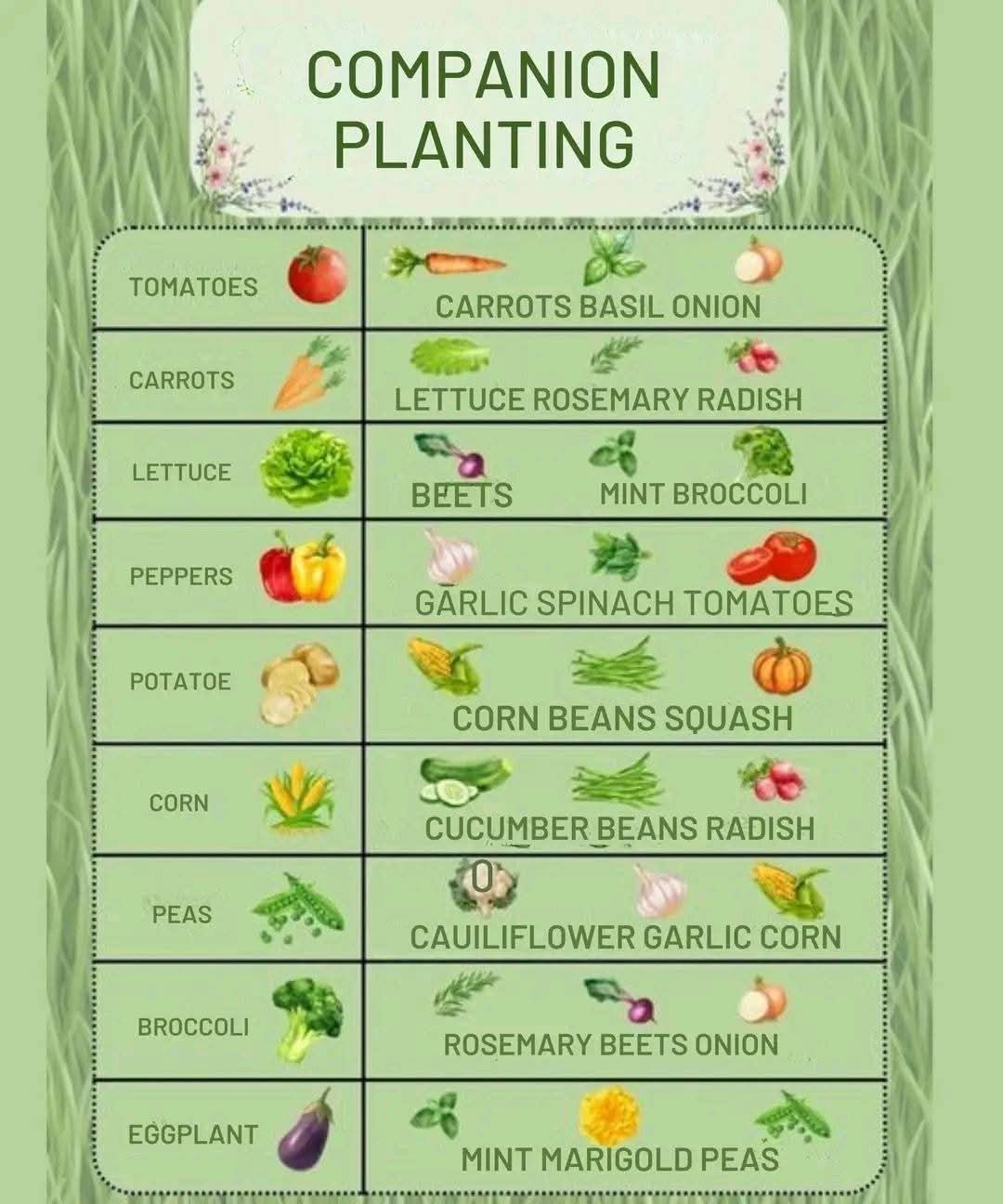Gardening isn’t just about planting seeds and hoping for the best—it’s about understanding how plants interact with one another. Companion planting is a powerful strategy that harnesses the natural relationships between plants to create a healthier, more productive garden. By carefully pairing crops, you can reduce pests, improve soil health, and maximize space, all while enhancing the flavor and growth of your plants.
Whether you’re a beginner or an experienced gardener, learning which plants grow well together can make a big difference in your harvest. This guide will break down the benefits of companion planting, the best plant pairings, and how you can apply these techniques in your own garden.
Benefits of Companion Planting
Companion planting isn’t just a gardening trick—it’s a science-backed method that has been used for centuries. Here are the top benefits of using companion planting in your garden:
- Natural Pest Control
Some plants naturally repel harmful insects with their scent or chemical compounds. This reduces the need for chemical pesticides and helps protect your crops naturally.
Example: Basil planted near tomatoes repels aphids and mosquitoes, keeping your tomatoes healthier.
- Improved Growth & Yield
Certain plants help each other thrive by enhancing soil quality, providing shade, or attracting beneficial insects.
Example: Beans fix nitrogen in the soil, which helps leafy greens like spinach and lettuce grow stronger.
- Maximized Space Usage
By pairing plants with different growth habits, you can use your garden space more efficiently.
Example: Planting carrots with tomatoes saves space because carrots grow underground while tomatoes grow upward.
- Better Soil Health
Some plants enrich the soil with essential nutrients, preventing depletion and reducing the need for fertilizers. Others help prevent erosion and improve soil structure.
Example: Legumes (like peas and beans) fix nitrogen in the soil, benefiting nearby crops.
By implementing companion planting techniques, you create a more balanced and self-sustaining garden ecosystem.
Best Companion Planting Combinations
- Tomatoes – Carrots, Basil, Onion
✔ Basil enhances tomato flavor and repels pests like mosquitoes and aphids.
✔ Carrots help loosen the soil for tomato roots.
✔ Onions repel common tomato pests.
- Carrots – Lettuce, Rosemary, Radish
✔ Rosemary deters carrot flies and aphids.
✔ Lettuce provides shade, preventing carrot roots from overheating.
✔ Radishes loosen compacted soil, helping carrots grow straighter.
- Lettuce – Beets, Mint, Broccoli
✔ Mint repels aphids, keeping lettuce pest-free.
✔ Beets grow well in the same space without competing for nutrients.
✔ Broccoli provides light shade, helping lettuce grow in hot weather.
- Peppers – Garlic, Spinach, Tomatoes
✔ Garlic repels aphids and spider mites.
✔ Spinach covers the soil, preventing weeds and retaining moisture.
✔ Tomatoes create a microclimate that helps peppers grow.
- Potatoes – Corn, Beans, Squash
✔ Beans fix nitrogen in the soil, benefiting potatoes.
✔ Corn provides natural shade for potatoes.
✔ Squash acts as a living mulch, keeping the soil cool and moist.
- Corn – Cucumber, Beans, Radish
✔ Beans add nitrogen to the soil, helping corn grow tall.
✔ Cucumbers cover the ground, reducing weeds and maintaining soil moisture.
✔ Radishes deter pests that attack corn.
- Peas – Cauliflower, Garlic, Corn
✔ Peas boost soil nitrogen, helping cauliflower and corn grow stronger.
✔ Garlic repels common pea pests.
✔ Corn provides natural support for pea vines to climb.
- Broccoli – Rosemary, Beets, Onion
✔ Rosemary repels cabbage moths and other pests.
✔ Beets improve soil conditions for broccoli.
✔ Onions keep aphids and caterpillars away.
- Eggplant – Mint, Marigold, Peas
✔ Mint deters aphids and flea beetles.
✔ Marigolds keep soil nematodes and pests at bay.
✔ Peas provide nitrogen, improving eggplant growth.
These companion planting combinations are proven to enhance growth, deter pests, and improve soil conditions in your garden.
How to Apply Companion Planting in Your Garden
Now that you know which plants grow well together, here are some practical steps to start using companion planting:
- Plan Your Garden Layout
Sketch a rough layout of your garden and group plants based on beneficial pairings.
Keep tall plants (like corn and tomatoes) on the north side to prevent shading smaller plants.
- Rotate Crops Each Season
Don’t plant the same crops in the same spot year after year. Rotate crops to prevent soil depletion and pest buildup.
Example: If you plant beans in one bed this year, grow tomatoes or peppers in that spot next year.
- Use Herbs and Flowers for Pest Control
Plant basil, rosemary, and mint throughout your garden to naturally repel pests.
Marigolds and nasturtiums attract beneficial insects and deter harmful bugs.
- Mix & Match Ground Covers
Pair climbing plants (like beans) with ground covers (like cucumbers or spinach) to use space efficiently.
Use low-growing plants like lettuce and radishes between taller crops.
- Observe and Adjust
Monitor how your plants respond to companion planting and make adjustments as needed.
If you notice stunted growth or pest issues, try rearranging your plant pairings.
Final Thoughts on Companion Planting
Companion planting is one of the easiest and most effective ways to improve your garden’s health. By strategically pairing plants that benefit each other, you can:
✔ Reduce pests naturally without harsh chemicals.
✔ Improve soil quality and reduce fertilizer needs.
✔ Increase your harvests by growing healthier plants.
✔ Make the most of your garden space, even in small areas.
Whether you’re growing vegetables, herbs, or flowers, companion planting can transform your garden into a thriving, self-sustaining ecosystem. Try incorporating these plant pairings into your garden this season and watch your plants flourish!
Have you tried companion planting before? What are your favorite plant pairings? Let me know in the comments!
More Articles You Might Like
-
Texas Toast Sloppy Joes: The Crunchy, Cheesy Upgrade You Didn’t Know You Needed
There’s something timeless about sloppy joes. For generations, this saucy, savory, and slightly sweet ground beef sandwich has been a go-to comfort food in American kitchens. It’s quick, filling, and family-friendly—perfect for busy weeknights. But what if we told you there’s a way to take this classic dish up a notch? Enter the Texas Toast…
-
Classic Pig Pickin’ Cake
When it comes to Southern desserts, few sweets shine as brightly as the Classic Pig Pickin’ Cake. This nostalgic cake, sometimes called a “Mandarin Orange Cake,” has roots deep in Southern tradition. It gets its playful name from its frequent appearance at pig pickin’s—Southern-style barbecue gatherings where communities come together to enjoy slow-cooked pork, sides,…
-
Lemon Garlic Butter Chicken with Creamy Parmesan Pasta
There’s something irresistible about the combination of tender, golden-browned chicken paired with a creamy pasta coated in Parmesan cheese. Add the brightness of lemon, the depth of garlic, and the richness of butter, and you have a recipe that feels indulgent yet approachable enough for a weeknight dinner. Lemon Garlic Butter Chicken with Creamy Parmesan…



